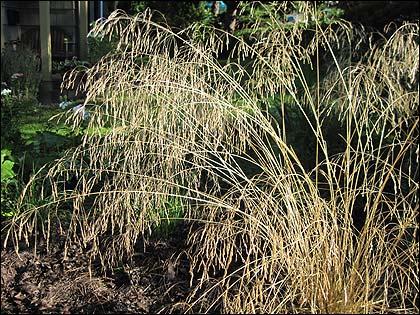
Skin of the Earth
Native grasses in the garden
By Rachel Foster
Grasses are an essential and often dominant component of natural landscapes, yet native grasses are scarce in the Willamette Valley. Farming did away with most native grasslands. Those that remained were quickly invaded by introduced grasses that easily out-compete native bunchgrasses. Bunchgrasses are relatively non-aggressive, and compatible with the non-grass, herbaceous flowering plants that most native gardeners want to grow. They are also beautiful. Including grasses in native gardens makes the gardens look more natural and visually interesting. It may even help in maintaining healthy populations of some of these species.
 |
| Tufted hairgrass |
Although grasses are a vital component of many ecosystems, to the average gardener “grass” means either turf grass or weeds. It’s true that ornamental grasses are gaining in popularity, but they are still an afterthought for many of us and we are mostly pretty weak on grass identification. Many grasses look alike to us, and it can be difficult to tell at first what’s a desirable grass and what is a weed.
So when I began to plan a native zone, complete with grasses, in my own yard, I decided to begin with a small number of grass species that I felt sure I could tell apart from one another. I also wanted to use grasses that are available as plant starts, not just as seed, so I will get to know the grasses better before I have to distinguish their seedlings from the zillion other grasses that fall out of the Willamette Valley sky. Since the area involved is small, I didn’t need a large number of starts.
My native zone consists of a flat area with rising banks on two sides. The flat part (the “wetland”) is squishy wet in winter and dries out slowly in summer, while the banks (my “upland slopes”) drain more readily and dry out by July. Both areas used to be covered with turf. They were smother-mulched in fall of 2009 with newspaper and wood chips and bark mulch, and left mostly unplanted for over a year to ensure that the existing grass was dead.
Meanwhile I admired a tall, wide bladed grass in my neighbor Whitey Lueck’s garden and asked him what it was. Blue wild rye (Elymus glaucus) was the answer. Lueck described it as his native bunch grass of choice, for its adaptability to a variety of conditions. He gave me some starts, which did very well. It seems to grow anywhere, wet or dry, in sun or shade. It can be cut back any time it gets untidy, and extras are easy to pull out. I already have seedlings, which are quite distinctive.
The next step was to acquire some Roemer’s fescue (Festuca roemeri), which naturalists consider the dominant grass of our upland prairies. It also grows in oak woodland and well drained meadows. This pretty, blueish-green, fine-textured grass won’t tolerate saturated soil. My plants, set out on the banks in early spring this year, grew readily, flowered quite early and then turned bone white, even before the ground dried out. I’m waiting to see if they come back to life when it rains. If not, I am hoping for some seedlings.
Anyone who travels through the valleys around Eugene should have noticed tufted hairgrass (Deschampsia caespitosa) making a golden haze over low-lying meadows in early summer — often the same damp meadows that earlier were blue with camas flowers. It is perhaps the only plant I have seen described as actually preferring poorly drained soils. It certainly likes mine. This very distinctive grass has a low tuft of rather stiff, deep green leaves from which emerges a fountain of tall stems (or culms), each stem topped by an airy panicle of bloom. The foliage stays green for a long time.
I got my grasses from a variety of sources, including Doak Creek Nursery and the nursery at Buford Park, which has a plant sale every spring. Other local nurseries that sell native grass plugs include Balance (wholesale only) and Trillium Gardens, both in Eugene, and Seven Oaks Native Plant Nursery in Albany. The nursery at Buford Park can also supply small quantities of seed.
Landscape ecologist Jason Blazar says all three of these grasses I’ve tried are easily propagated from seed. Simply broadcast over bare ground, he says, and plants should germinate in 10-30 days if sown Sept. 30 to Nov. 15.
Among other grasses Blazar suggested I might try are three for moderately drained soils such as you find at the margins of wetlands: California brome (Bromus carinatus), California oatgrass (Danthonia californica) and June grass (Koeleria macrantha).
Rachel Foster of Eugene is a writer and garden consultant. She can be reached at rfoster@efn.org